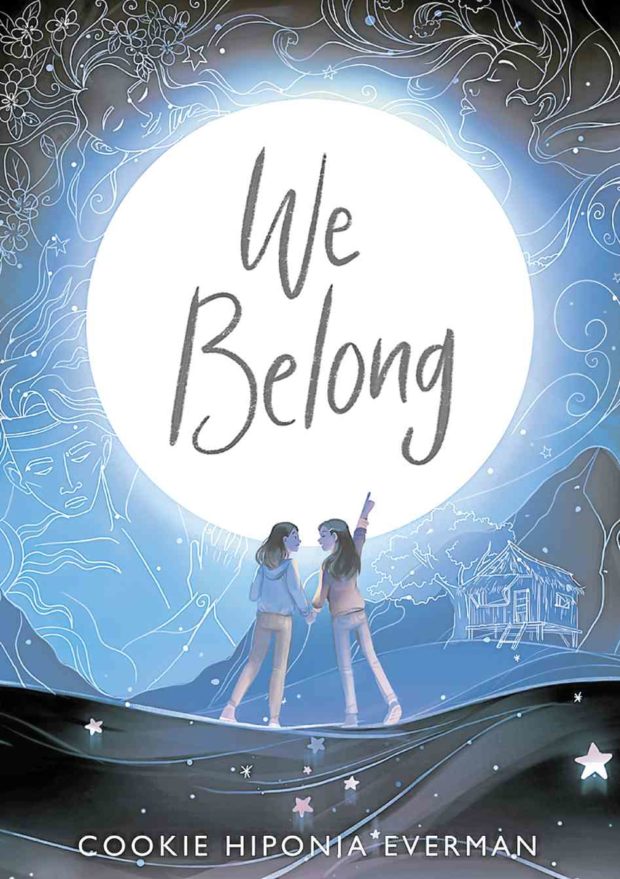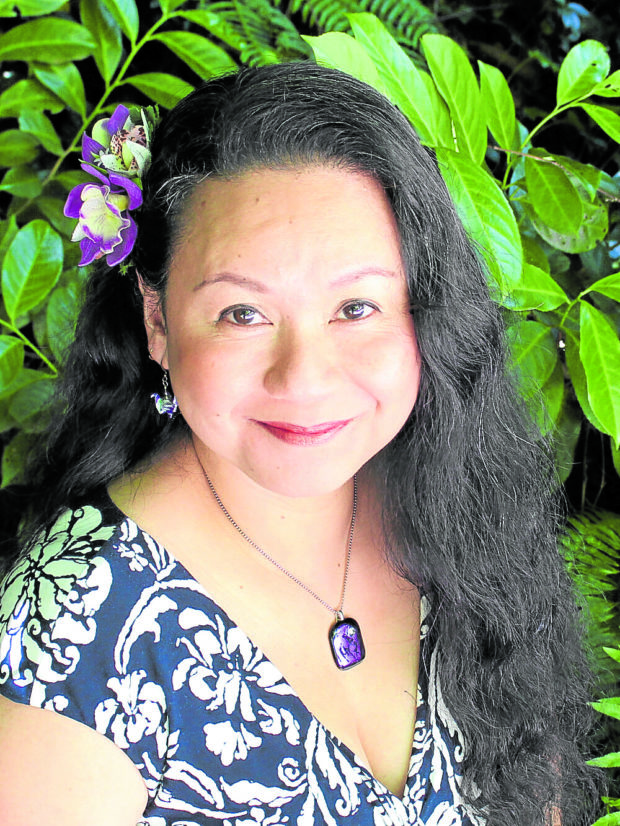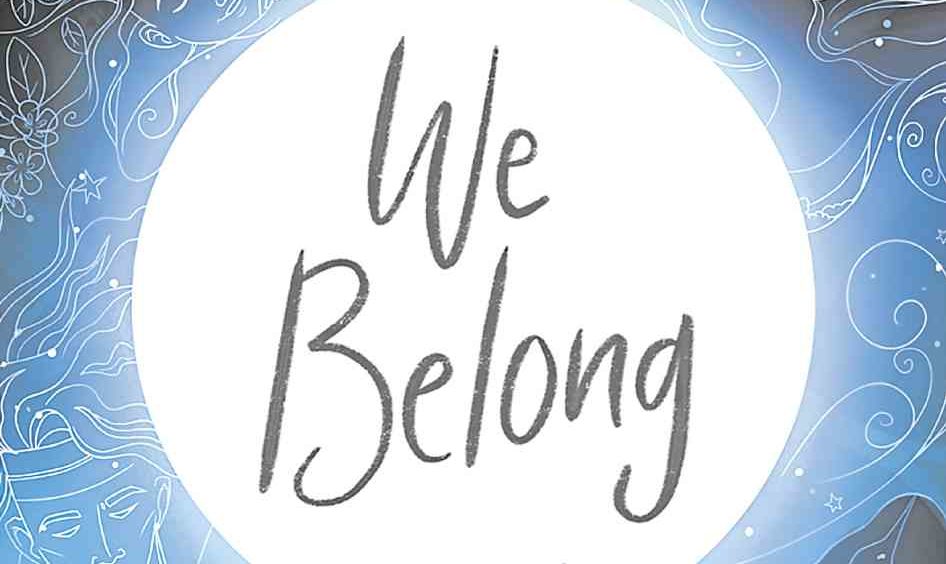Imagine if one person’s story is a sky where every element in it holds its place with its own story. That is the extraordinary case of “We Belong” (Dial Books for Young Readers, New York, 2021, 201 pages), Cookie Hiponia’s debut novel (age 10 and up), which is written in verse. The 46-year-old Hiponia (the book was published under her former name of Cookie Hiponia Everman) spent her childhood in Makati and Ayala Alabang, the daughter of two businesspeople. “I had a pretty idyllic childhood in Manila, for the most part; my brother and sister and I grew up in neighborhoods where there were lots of neighbor kids to play with,” until her family immigrated to the United States when she was 9, in 1984, during the turmoil under the dictatorship of Ferdinand Marcos and soon before the Edsa Revolution.
She then graduated from the University of Maryland with a BA in Journalism and a BA in Chinese Languages and Literature. “I thought I was going to be a cultural attaché, but the universe had bigger plans for me, and here we are. I would have made a terrible cultural attaché anyway; I’m not very diplomatic at all.”
She then worked as an editor on the video games Mass Effect 1 and 2, Sonic Chronicles: The Dark Brotherhood, Destiny 2, Forsaken and Rise of the Iron Lords. She lives in Seattle; older daughter Diana turns 13 in June, and Tala turned 11 in March.
What makes “We Belong” special isn’t just it being written in verse. Beginning with mom Elsie putting her daughters Luna and Tala to sleep and being asked for a bedtime story, the novel tells two parallel stories, both different kinds of Filipino tales.
One is a retelling of the mythological story of how Bathala the Creator’s children Apolaki became the sun, Buan became the moon and Tala the stars. The other story is about how Elsie’s family, the Aguilas, left behind a comfortable life in the Philippines to build a life in the United States.
These two stories are told in beautiful verse side by side as Elsie expresses to her children how much they mean to her, how much they are the elements in her sky. It also acts as a coming-of-age tale for Elsie. Not only does “We Belong” honor Hiponia’s origins through mythology and pop culture memories; it also recognizes the resilient Filipino Americans who have overcome being outsiders to find their own places wherever they are. And though the book is classified as juvenile fiction, Hiponia says it’s for “anyone who needs to know they are seen, heard, loved, just as they are wherever they are.”
Lifestyle asked the outspoken Hiponia questions over email. Here are excerpts:
Why did you write ‘We Belong’ in verse?
Poetry is the closest thing I can call the language my heart has spoken since before birth. It’s the genre that feels most natural for me to write in. I explain this particular creative choice in the afterword: “… Like many tribal societies, Filipinos passed on their stories and their knowledge of the earth to their children through song. Poetry is music, poems are songs, and so I wrote this story in poems to pass on my story, Elsie’s story, Buan Mayari’s story, through song.”
Just how much of ‘We Belong’ is autobiographical and how much of it is fictionalized?
I explain all of this in the afterword: “Many of the stories Elsie tells in this book are stories from my life … Like Elsie, I was also an outspoken young lady who briefly lost her voice and name on the way to my new home …” And anyway, it doesn’t matter if it’s 50/50 autobiographical or 70/30 or 0/100. All these stories are stories that happened to people and they’re all true, whether or not they happened in real life. Reality and truth are two different things, you see, and sometimes you have to bend reality to tell the truth.
One of the elements in ‘We Belong’ seems to be that life in the United States can be difficult for those immigrating from a country they grew up in, kind of a more nuanced view of the American Dream. How does that work into your thought process for ‘We Belong?’
Do you remember the movie “An American Tail?” That was the perfect encapsulation of what it feels like to immigrate to America. Hollywood convinced us that America was a land of opportunity and where anyone can make it if they just work hard enough. So, we immigrants sing songs about streets paved in gold and all the Spam we can eat …
And then, we get here and discover that we must go work at McDonald’s after being VP of sales at the third largest corporation in Manila. I think it’s telling that you find it surprising that life in America is so hard for immigrants. That means the American Dream brainwashing still has power. That’s why I wanted to burst that bubble once and for all by telling my family’s very real story of going from a swank house in Ayala Alabang Village to a damp basement apartment in Jersey City, all because we wanted to be safe from the terrifying things the Philippine government was doing under a dictator like Marcos.
It doesn’t escape my notice, of course, that the current President of the Philippines has been called “The Trump of Asia.” That should especially tell you the state of the US after Trump. This is also why I don’t understand why anyone would ever think that immigrants want to leave their homelands just for kicks. Things in Guatemala must be REAL BAD if Guatemalans want to risk everything to come to America.
The lines ‘We are immigrants/We get the job done’— is that a ‘Hamilton’ shoutout?
ABSOLUTELY. It’s always a risk you take if you make a pop culture reference in a book because that immediately puts the book into a specific time period, and you want books to be as timeless as possible. But it’s actually one of the lines I convinced my editor to keep after editing, because that line was the one that resonated most with my 9- to 12-year-old beta readers. For most of my kid readers, the musical “Hamilton” was their first exposure to a story told in song or verse about the immigrant experience in America.
How did you decide to weave together the parallel stories of the Aguilas’ immigration odyssey and the Filipino mythological story?
When I first started writing “We Belong” in earnest, I started thinking about which of our myths I wanted to use as a parallel to the immigrant story. I’m not just a poet, I’m a giant poetry and mythology nerd and this is my first book, so I’m busting out the gate at full speed. Poetry AND mythology in the same book!
But seriously, this is the thing we all need to not only learn, but also remember: There are no new stories, only new ways to live and tell them. To help us all learn and remember, I chose to weave the myth into the modern, as a very stark illustration of how we keep living the same stories over and over. Maybe if we recognize the parts of the patterns we keep repeating that aren’t working with the overall form and function of what we are weaving, we’ll weave something new, something stronger or more sturdy or prettier or more colorful.
Where did you draw the elements of the Filipino mythological story from?
I knew bits and pieces of the Araw/Apolaki vs. Buan/Mayari fight in mythology and it reminded me so much of the rivalry between me and my kuya growing up. He’s two-and-a-half years older than me, so I came up after him in school … I absolutely hated the idea that my identity was tied to my relationship with a boy, especially when I’m so much better at so many things than most boys and men.
I started thinking about how Mayari must feel that she is a bit of an asterisk in the story of how the sun came to be, which is probably the same way Dinnah in the Bible must feel because her story is an afterthought in the story of Jacob and Esau.
I refuse to be the afterthought or asterisk in anyone’s story. I am the hero of my own story, just like everyone is the hero of theirs. So, I imagined Mayari as Wonder Woman, this warrior who uses her vulnerability (her love for humanity, especially one special person, who was Steve for Wonder Woman and Tala for Mayari) as her armor, and protects what she loves. Imagine: if the only way Apolaki could defeat Mayari was to take out her eye, she must have been a certified badass!

The Aswang Project (aswangproject.com) was an excellent resource for my research, especially as a jumping-off point for other resources. I also read Lane Wilcken and Leny Mendoza Strobel, as well as Jessica Hagedorn’s “Dogeaters” and Cecilia Manguerra Brainard’s “When the Rainbow Goddess Wept.” I used Liana Romulo’s story “A Bridge of Flowers” as a reference for the poems about Bighari.
See? No new stories, only new ways to tell them for a new audience.
In the book, you think about having stayed and if you ‘had dared to oppose a dictator’ and ‘I would not be free to write of dissent and resistance.’ Can you elaborate on that?
Do you honestly think I could have written, published and promoted a book like this while living in the Philippines under Duterte—even under Erap—and survived to give you this interview? We all know that answer is “No.” Ninoy could tell you the answer is “No,” except that he was murdered for leading the resistance against Marcos. So, yeah, I had to write “We Belong” as a Filipino American living in America.
How long did it take you to write the book, and what did you consider the most difficult part of writing it?
I feel like I had been writing the book for 37 years of living in America as a Filipina. What I mean is that I’ve been a writer for as long as I can remember, and I’ve kept as much of my writing as I could since I was 12. I even kept four large coffee cans of the notes my friends and I passed to each other in high school … Anyway, when I decided I would write an actual book with a full narrative arc, from the time that I wrote the outline to the time I turned in the manuscript to my editor, it was about two years. I bought myself a bottle of expensive Scotch to celebrate when I turned it in. During the first year of drafting, I was still working as a video game editor full time and raising my two daughters. I wrote the book on the bus, on coffee breaks, at lunch, during boring meetings, on the back of grocery store receipts while waiting in the parent pickup line after school, on the margins of my hula notebook next to drawings of hand gestures. And yet the most difficult part of writing it was explaining the process of writing it, just now, to you!
So, what inspired this book? I love the idea of a personal immigrant memoir that is also a bedtime story.
Toni Morrison said famously, “If there’s a book you want to read, and it hasn’t yet been written, then you must write it.”
When my kids were small, I was a full-time housewife and mama, which means I had to entertain and/or educate them all day. I’m a giant book nerd, so we were at the library a lot. I always looked for Filipino or Tagalog books for them, and while we found many that are now family favorites, like “Cora Cooks Pancit” by Dorina Lazo Gilmore, there were no books that spoke to their experiences as hapa kids (Editor’s note: a Hawaiian word, meaning “half”—“half-Asian and half some other ethnicity”).
And a lot of the immigrant stories I had read that were written for kids focused so much on the suffering and the trauma of a refugee story or an undocumented migrant story, and while those stories are valid and deserve to be told, the stories of highly educated immigrants who leave their homelands to become McDonald’s cashiers or Uber drivers in America, working three to five jobs at a time just to survive, also deserve to be told.
Parents have the responsibility to pass on the stories of their people to their children, but how exciting or inspiring is a bedtime story that goes, “We got on a plane, we worked till our fingers bled just to put food on the table, we were treated like second-class citizens, and we just prayed our children’s lives would be better.” Nah. You have to make it epic! Mythological! Because it is.
The monumental sacrifice my parents made to leave everything they knew and everyone they loved to give their children a better life than they had is just as epic as the battle between the Moon Goddess and the Sun God to rule over the Kingdom of Heaven.
Did you get to sing those songs to your kids or read the book to them?
I sang “Bahay Kubo” to my kids when they were little, and there’s a video on my YouTube channel of Diana singing “Bahay Kubo” when she was 2 years old. They were literally the very first people who read the first finished draft of “We Belong.” I wrote “The End,” yelled YESSS in my office, printed out the whole thing, and asked them to read it. They each finished it in about 30 minutes and said, “This is so great, Mama! Yay!” So that’s what two years of writing yields: a half-hour of entertainment for a middle-grade reader. I made each of them read it again. And then a third time to answer questions about how I can make it better for them. Yeah, I’m a jerk, but only for things that are important.
What are you busy with now and what is next for you?
I’m busy promoting “We Belong,” since releasing a debut book in the middle of a global pandemic means I don’t get a book tour, which means I have to hustle harder to promote it. So, I’ve been driving around the Seattle Metro area and suburbs to sign books at independent bookstores and donate books to Little Free Libraries and the Filipino Community of Seattle’s community center. Right now, they’re just doing meals for seniors, so I’ve volunteered to help with that for now, but I’m hoping I can start working with the youth program and read and write stories like “We Belong” with them. I’m also writing another middle-grade book, not told all in free verse but told in text messages and journal entries, which is the vernacular of the 12-year-olds I know. It also has a Filipino American protagonist and weaves Filipino mythology and a touch of poetry in the telling because I can’t help it, but also because it’s the best way I could think of to tell the story I’m telling.
Your book comes out at a time when Asian American violence seems to be at a high. What can you say about what is happening?
How many more books like “We Belong” do we have to write before America remembers that we are people, before y’all recognize our humanity, before y’all stop exploiting and killing us? We built this country, fairly literally. From the Filipinos who jumped the Spanish galleons to establish communities in Louisiana to the Chinese who built the railroads across the country to the Japanese who planted most of California’s crops to the South Asians who started Silicon Valley companies, to the Hmong, Vietnamese, Laotian, Cambodian communities who feed us and make our nails pretty. We built this country, and we belong.
If there is one thing you want readers to take with them after reading ‘We Belong,’ what would it be?
It’s in this lyric from one of my favorite Joey Ayala songs (Editor’s note: the song is “Buwan, Buwan”), which is on the Spotify playlist I made of songs that are referenced in or inspired “We Belong”: “Bigyan ng ginhawa hagkan ng pahinga/ Nag-iipon siya ng lakas/Upang harapin ang bukas.” Loosely and poetically translated, it says that the moon is giving you a kiss of rest so you can gather your strength to face tomorrow.
Life is hard sometimes, and the world is cruel sometimes, but look for the points of light in the darkness, look for your sun, moon and stars to guide you into the morning, no matter how dark the night has been. And always remember that YOU BELONG. WE ALL BELONG.
Maybe America doesn’t want me or you to belong to it because we’re too brown or Black or queer or female or loud or whatever else it comes up with as to why someone is not good enough to belong, but knowing that I belong to the people who I’ve chosen to belong to helps me to face tomorrow. And keep loving, keep fighting, for me and my people. We are all we’ve got. INQ
Available in hardcover from Fully Booked and fullybookedonline.com.









































